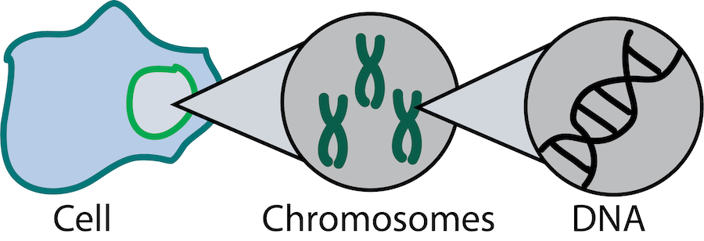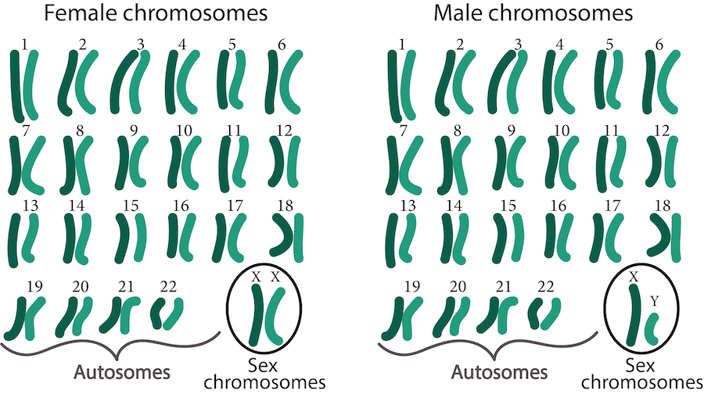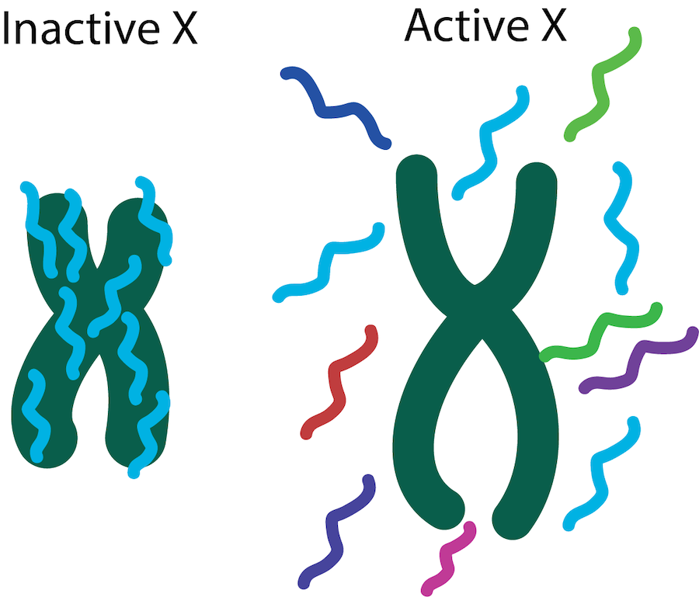
What would happen if X-inactivation didn’t occur properly?
December 6, 2019

- Related Topics:
- X inactivation,
- Chromosomes,
- Epigenetics,
- Gene expression
An undergraduate student from India asks:
"What if some mutation occurs to the Xist gene and X inactivation does not occur? Have any such cases been reported?"
X chromosome inactivation is a complicated process, but let’s get back to the basics for a second.
DNA is the instruction manual for our cells
First, let’s talk about DNA. All living organisms have DNA and we use it as an instruction manual to make up everything about ourselves. DNA determines everything from hair color to whether your ear lobes are dangly or attached to your head.

What are chromosomes?
We have a lot of DNA in our bodies. To make sure it doesn’t get tangled or damaged, our DNA is compacted into little noodle-looking things called chromosomes.
Usually, humans have 23 different pairs of chromosomes. You get 1 of each pair from mom and one from dad. 22 of these pairs are called autosomes. Autosomes are the same in both males and females.
The last pair of chromosomes are called sex chromosomes. They determine whether you are biologically male or female. There are two flavors of sex chromosomes: X and Y. Males have one X chromosome and one Y chromosome, while females have two X chromosomes.

Why do we care how many chromosomes we have?
Chromosomes are just condensed DNA. If there is too much or too little DNA in a cell, the cell will not have the correct instruction manual. Can you imagine assembling a model airplane with pages missing from the instruction manual? Or if pages were duplicated?
In general, having too many (or too few) chromosomes means the cell will not live. There are a few cases where this is survivable, but even then the extra chromosomes cause problems. For example, having an extra copy of Chromosome 21 causes Down Syndrome.
So if having different numbers of chromosomes is bad, how can males survive with one X and females survive with two X chromosomes?
The reason is that one of the X chromosomes always gets turned off in females —just like switching off a light switch. So it’s actually like everyone only has one X chromosome!
How do females silence one of the X chromosomes?
DNA is the instruction manual. It’s organized into smaller chunks called genes. Each of these genes has instructions to make all the things our cells need to survive.
But genes can’t carry these instructions to the cell. RNA is the molecule that actually takes the information out into the cell.
RNAs carry all the recipes for the proteins and enzymes in us. These proteins do everything from digest food to replicating our DNA and more!
But there are also RNAs that don’t have instructions for proteins. These RNAs can have lots of different jobs, but the only one I will talk about here is called Xist. This RNA is important for turning off one of the X chromosomes in females.
Every X chromosome has an Xist gene, which produces Xist RNA. Xist RNA goes and sticks on to the other X chromosome. If enough Xist RNA covers a chromosome, nothing on that chromosome can be used. It’s effectively switched off, or silenced.
The RNA coating makes the X chromosome pack together more tightly. More tightly packed DNA is hard to access. It’s kind of like a tightly braided rope – sometimes you can’t even see the inner strands of string that make up the rope. This makes it less accessible to the proteins that could make more RNAs and proteins.1

Which X chromosome is silenced is random. When the embryo is still developing, both X chromosomes will produce Xist RNA. It’s a race to see which one silences the other first. Once an X chromosome is silenced, it stops making Xist RNA. The remaining, unsilenced X chromosome takes over all the X chromosome duties in the cell.
This silencing is permanent. Once an X chromosome is silenced, it won’t ever turn back on. The working X chromosome keeps making Xist, keeping the other one coated and inactive. Even if the cell divides, the new cells will keep the same silencing pattern.
A classic example of this is the tortoiseshell cat. Since one coat color gene is on the X chromosome, if a female cat has one orange version and one black version she will have a patchwork coat. You can literally see which chromosome is active!

So, what happens when Xist doesn’t work?
If the Xist gene is turned off or mutated on one X chromosome, the Xist gene on the other one will still work. The working Xist gene will produce Xist RNA that coats and turns off the X chromosome with the broken Xist gene.
If both Xist genes are broken, it’s a different story. In that case, neither X chromosome would be silenced. This is lethal in humans. There hasn’t been a single reported case of someone surviving with multiple unsilenced X chromosomes. In mice, it is usually lethal – and even if the mice survive, they have severe developmental defects.1
Our genes are under very tight regulation to produce the right amount of RNA in every situation. When things are mis-regulated, it often leads to disease. If all of the genes on the X chromosome were doubled, the expression of those genes would be severely mis-regulated. To compensate for this, the entire chromosome is silenced.

Author: Kelsey Fryer
When this answer was published in 2019, Kelsey was a Ph.D. candidate in the Department of Genetics, studying underlying sequence contribution to centromere function in Aaron Straight’s laboratory. She wrote this answer while participating in the Stanford at The Tech program.
 Skip Navigation
Skip Navigation
